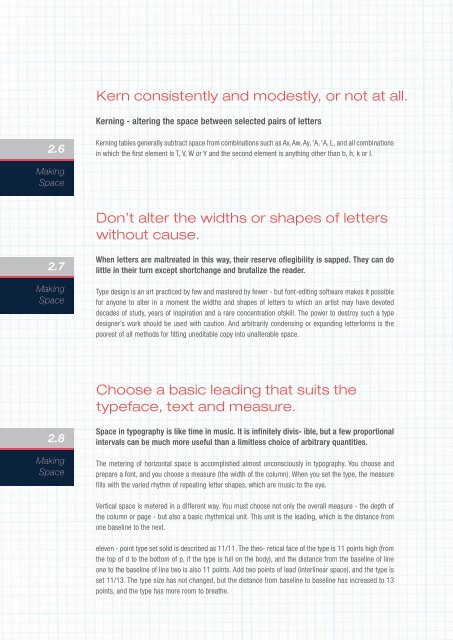5 Trick Pony Brand Guidelines v3
You also want an ePaper? Increase the reach of your titles
YUMPU automatically turns print PDFs into web optimized ePapers that Google loves.
Kern consistently and modestly, or not at all.<br />
Kerning - altering the space between selected pairs of letters<br />
2.6<br />
Kerning tables generally subtract space from combinations such as Av, Aw, Ay, ‘A, ‘A, L, and all combinations<br />
in which the first element is T, V, W or Y and the second element is anything other than b, h, k or I.<br />
Making<br />
Space<br />
Don’t alter the widths or shapes of letters<br />
without cause.<br />
2.7<br />
Making<br />
Space<br />
When letters are maltreated in this way, their reserve oflegibility is sapped. They can do<br />
little in their turn except shortchange and brutalize the reader.<br />
Type design is an art practiced by few and mastered by fewer - but font-editing software makes it possible<br />
for anyone to alter in a moment the widths and shapes of letters to which an artist may have devoted<br />
decades of study, years of inspiration and a rare concentration ofskill. The power to destroy such a type<br />
designer’s work should be used with caution. And arbitrarily condensing or expanding letterforms is the<br />
poorest of all methods for fitting uneditable copy into unalterable space.<br />
Choose a basic leading that suits the<br />
typeface, text and measure.<br />
2.8<br />
Making<br />
Space<br />
Space in typography is like time in music. It is infinitely divis- ible, but a few proportional<br />
intervals can be much more useful than a limitless choice of arbitrary quantities.<br />
The metering of horizontal space is accomplished almost unconsciously in typography. You choose and<br />
prepare a font, and you choose a measure (the width of the column). When you set the type, the measure<br />
fills with the varied rhythm of repeating letter shapes, which are music to the eye.<br />
Vertical space is metered in a different way. You must choose not only the overall measure - the depth of<br />
the column or page - but also a basic rhythmical unit. This unit is the leading, which is the distance from<br />
one baseline to the next.<br />
eleven - point type set solid is described as 11/11. The theo- retical face of the type is 11 points high (from<br />
the top of d to the bottom of p, if the type is full on the body), and the distance from the baseline of line<br />
one to the baseline of line two is also 11 points. Add two points of lead (interlinear space), and the type is<br />
set 11/13. The type size has not changed, but the distance from baseline to baseline has increased to 13<br />
points, and the type has more room to breathe.





